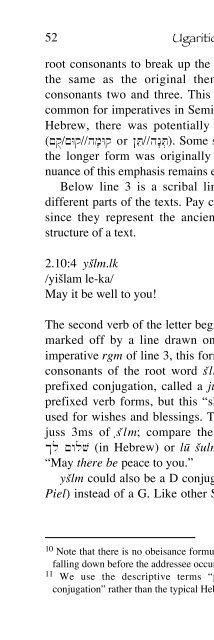A Primer on Ugaritic: Language, Culture, and Literature - enenuru
A Primer on Ugaritic: Language, Culture, and Literature - enenuru
A Primer on Ugaritic: Language, Culture, and Literature - enenuru
Create successful ePaper yourself
Turn your PDF publications into a flip-book with our unique Google optimized e-Paper software.
52<br />
<strong>Ugaritic</strong> <str<strong>on</strong>g>Primer</str<strong>on</strong>g><br />
root c<strong>on</strong>s<strong>on</strong>ants to break up the c<strong>on</strong>s<strong>on</strong>ant cluster. This vowel is<br />
the same as the original theme vowel, the vowel between<br />
c<strong>on</strong>s<strong>on</strong>ants two <strong>and</strong> three. This is called vowel harm<strong>on</strong>y <strong>and</strong> is<br />
comm<strong>on</strong> for imperatives in Semitic languages. Additi<strong>on</strong>ally, as in<br />
Hebrew, there was potentially a l<strong>on</strong>ger form of the ms impv<br />
(Müq/M…wq//hDm…wq or NE;t//hÎnV;t). Some scholars think that the final -h of<br />
the l<strong>on</strong>ger form was originally “emphatic,” though the precise<br />
nuance of this emphasis remains ellusive.<br />
Below line 3 is a scribal line, which was used to separate<br />
different parts of the texts. Pay careful attenti<strong>on</strong> to such markings<br />
since they represent the ancient scribes’ underst<strong>and</strong>ing of the<br />
structure of a text.<br />
2.10:4 ysûlm.lk<br />
/yisûlam le-ka/<br />
May it be well to you!<br />
The sec<strong>on</strong>d verb of the letter begins the Type II Greeting, <strong>and</strong> it is<br />
marked off by a line drawn <strong>on</strong> the tablet. 10 In c<strong>on</strong>trast to the<br />
imperative rgm of line 3, this form has a prefixed y- preceding the<br />
c<strong>on</strong>s<strong>on</strong>ants of the root word sûlm. ysûlm is a short form of a G<br />
prefixed c<strong>on</strong>jugati<strong>on</strong>, called a jussive. 11 There are a variety of<br />
prefixed verb forms, but this “shortened” form—the jussive—is<br />
used for wishes <strong>and</strong> blessings. The parsing can be abbreviated G<br />
juss 3ms of sûlm; compare the simple n<strong>on</strong>verbal expressi<strong>on</strong>s,<br />
Kl Mwlv (in Hebrew) or luœ sûulmu ana muh˙h˙ika (in Akkadian),<br />
“May there be peace to you.”<br />
ysûlm could also be a D c<strong>on</strong>jugati<strong>on</strong> (compare with the Hebrew<br />
Piel) instead of a G. Like other Semitic languages, <strong>Ugaritic</strong> has a<br />
10 Note that there is no obeisance formula. This formula referring to the speaker<br />
falling down before the addressee occurs <strong>on</strong>ly with the Type I Heading.<br />
11 We use the descriptive terms “prefixed c<strong>on</strong>jugati<strong>on</strong>” <strong>and</strong> “suffixed<br />
c<strong>on</strong>jugati<strong>on</strong>” rather than the typical Hebrew terms “imperfect” <strong>and</strong> “perfect.”


